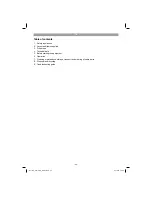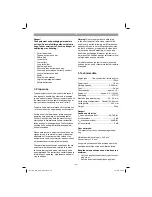
GB
- 24 -
Repeat the test several times after the engine
has started up. When the engine start/stop lever
is released, the engine must stop within a few se-
conds. If not, contact Customer Service.
Danger:
The blade begins to rotate as soon as
the engine is started.
6.1 Starting the engine
1. Ensure that the ignition cable is connected to
the spark plug.
2. Press the fuel pump (primer) (Fig. 6/Item 2)
three times. You can skip this point if the engi-
ne has already warmed up.
3. Stand behind the lawn mower. Actuate the
engine start/stop lever (Fig. 5b) with one
hand. The other hand must be on the starter
handle.
4. Start the engine using the reversing starter
(Fig. 1/Item 9). To do this pull out the handle
approx. 10 –15 cm (until you feel a resistance)
and then start the engine with a sharp tug.
If the engine does not start, tug the handle
again.
Note!
Never allow the actuator cable to snap
back.
Note!
In cold weather, it may be necessary to
repeat the starting process several times.
Drive unit
Drive lever/clutch lever (Fig. 5a/Item 1b):
If you press this (Fig. 5c) the clutch for the drive
will be closed and the lawnmower will start to
move with the engine running. Release the drive
lever in good time to stop the moving lawnmower.
Practice starting and stopping before you use the
mower for the
fi
rst time until you are familiar with
controlling the mower.
6.2 Tips on mowing properly
Danger!
Never open the chute
fl
ap when the grass
bag has been detached (to be emptied) and
the engine is still running. The rotating blade
can cause serious injuries!
Always carefully fasten the chute
fl
ap and
debris bag. Switch o
ff
the engine before you
remove them.
Whenever you need to perform any kind of
adjustment, maintenance or repair work,
switch o
ff
the engine and wait until the blade
no longer rotates. Pull o
ff
the spark plug con-
nector.
Mowing
The engine is con
fi
gured for an optimal grass cut-
ting speed, for ejecting grass into the debris bag,
and for many years of use.
Only use a sharp blade that is in good condition.
This will prevent the grass blades from fraying
and the lawn from turning yellow.
Try to mow in straight lines for a nice, clean look.
The swaths should overlap each other by a few
centimeters in order to avoid stripes.
Keep the underside of the mower housing clean
and remove grass build-up. Deposits not only
make it more di
ffi
cult to start the mower; they
decrease the quality of the cut and make it harder
for the equipment to bag the grass.
Always mow along inclines (not up and down).
You can prevent the lawn mower from slipping
down by holding a position at an angle upwards.
Select the cutting height according to the length
of the grass. If necessary, mow a number of times
so that you never cut more than 4cm of grass in
one go.
Switch o
ff
the engine before doing any checks on
the blade. Keep in mind that the blade continues
to rotate for a few seconds after the engine has
been switched o
ff
. Never attempt to manually
stop the blade. Regularly check to see if the
blade is securely attached, is in good condition
and is sharp. If the contrary is the case, sharpen
the blade or replace it. In the event that the blade
strikes an object, immediately switch o
ff
the lawn
mower and wait for the blade to come to a com-
plete stop. Then inspect the condition of the blade
and the blade mount. Replace any parts that are
damaged.
Anl_GC_PM_46_S_SPK7.indb 24
Anl_GC_PM_46_S_SPK7.indb 24
31.10.14 12:24
31.10.14 12:24
















































